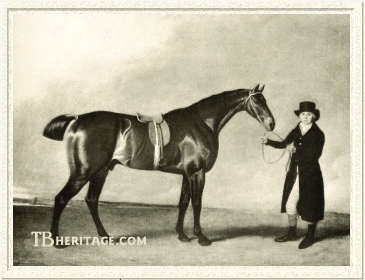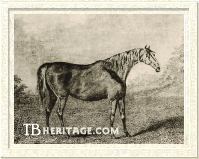|
|
Sir Harry

|
|
 |
|
|
Sir Harry, a rich brown horse, 15 1/2 hands high, won the Epsom Derby of 1798, the first son of a previous Derby winner to also win the "Blue Riband." His other wins in England were the Claret Stakes and a King's Plate. He retired to stud in 1803 at Cannons, and the following season was moved to Clay Hill, both the property of Andrew O'Kelly, the nephew and heir of Dennis O'Kelly, owner of Eclipse.
In the fall of 1804 William Haxall of Petersberg, Virginia, purchased him; by the time Sir Harry arrived in America, his combined purchase and shipping price of £1200 sterling was the highest paid up to that time for an English horse by an American buyer. He stood in Virginia between 1805 and 1816, and then went to Havre de Grace in Maryland for the remainder of his stud career.
|

Medora
| |
In England he left behind an unnamed daughter (1803, from a Volunteer mare). This daughter produced Medora, an 1811 chestnut filly, by Selim, who became an top runner for the Duke of Rutland, winning the Oaks at age three, beating a good field that included Vestal (by Walton), Wire (by Waxy) and six others, after running third in the One Thousand Guineas. She went on to win a number of races, including the Windsor Forest Stakes, the Billingbear Stakes (Ascot), some minor sweepstakes and receiving some forfeits. She ran second in a sweep at Newmraket, beating Blucher, and second in Newmarket's Oatlands Stakes, beating Doncaster Cup winner Slender Billy.
|
In the stud Medora produced another Oaks winner in Gulnare (1824, by Smolensko), and through her was second dam of Two Thousand Guineas winner The Corsair. The good staying mare of the 1840s, Coranna (Cesarewitch, Chester Cup), also descended from this daughter of Sir Harry.
In America, Sir Harry's two best sons were Sir Alfred, 1806, from Lady Chesterfield (*Diomed), who ran two opening dead heats with Duroc in the twenty-mile race at Fairfield in 1810 (won by Maria); and Sir Hal, 1809, from an imported
Saltram Mare, who defeated Cupbearer at Broad Rock in 1914, setting a new American record for 4 miles in 7:42. Sir Hal won 12 out of 15 races, beating the best horses of his day and was considered to be a beautiful galloper. These two sons, along with daughter Atalanta (1807), propelled Sir Harry into leading sire status in the interval between when the last *Diomed offspring were on the turf and when the first Sir Archy youngsters began to appear in 1814.
Sir Harry also sired Haxall's Moses in 1815 who, in Kentucky, got several important broodmares, including the dam of Rodolph, who led eventually to Spendthrift. Another daughter of *Sir Harry's, Lady of the Lake (1813), was the fifth dam of Himyar.
--Patricia Erigero
|
|
|
|

